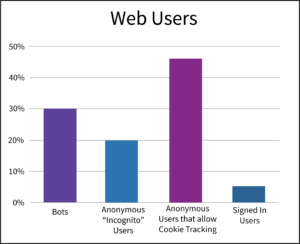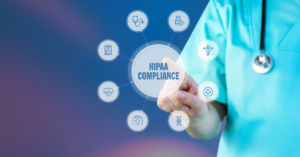Series Part 2/6: Answering the Question “Who is the User?” to Optimize an Experience
By Justin Bougher
March 2, 2020
Share
The first question we’re tackling is perhaps deceptively straightforward seeming, Who is the user? It sounds simple, but it has some nuance to it that we should explore. Let’s start with an example. I aggregated some data from SiteSpect’s customer base, and found the following information on who the user is.

As you can see, on aggregate, the sampled websites are getting 30% bot traffic, 20% anonymous “incognito” users, 45% anonymous users that allow cookie tracking, and 5% signed in users. Note, this is not meant to be representative of websites in general, but one example of a hypothetical traffic breakdown. So what do we do with this information?
Human or Robot?
Though often overlooked, the first question to consider is how much traffic comes from bots. It’s very typical to see over 30% of traffic coming from bots. Good bots, used for things like indexing your site for search, are easy to detect because they usually self identify. Bad bots, however, are designed to pretend to be real users in order to capture data from your site — or other undesirable activity. To manage this, you have to understand whether your analytics or optimization software can identify and exclude bots from both your analytics and personalization software. If you can’t easily get a clear answer, this traffic is probably being mishandled. SiteSpect, for example, filters out bad bots and allows you see how many are hitting your site. Make sure whatever analytics tool you use does the same.
What if the User is Anonymous?
Once you’ve filtered through your bot traffic, you can identify the rest of your users. However, this doesn’t require as much information as it may seem. You don’t need a name, or a formal identifier, to understand who you user is. A lot of information can be aggregated over time to create an anonymous user profile to understand who your user is. Here are some steps to understanding anonymous users.
- User agents – Every request to your website contains a user agent. This has information in it that can lead to understanding the user’s geolocation, device, browser, etc. Make sure your optimization or analytics software can gather this information on the first request, as it will become valuable when you begin answering the question, What experience should we show that user?
- First-party cookie – Anonymous users that visit your site more than once will contain first-party cookies. This allows you to capture previous visit user behavior to get a better understanding of things like likes and dislikes, patterns, and points of friction.
- Third-party cookies – There are many ad tracking offerings that capture cross-site information about users that can provide meaningful insights. However, since many browsers are now blocking third-party cookies by default, you will need to be careful about how you segment and record this traffic.
What if the User Doesn’t Want to be Tracked?
It’s important to understand that users may not want you to know who they are. Privacy laws like GDPR and CCPA along with new browser capabilities like Safari ITP and FireFox ETP reflect the clear message that users value privacy now more than ever. So, when you begin answering the question, Who is the user?, understand that the type of information you can get depends greatly on the user and the experience. This just means that when you begin designing and optimizing an experience for those users, you need make sure that includes building trust. User privacy and data protection is part of the customer experience.
Understanding Signed in Users
Some users will log in to your site, self-identifying and giving you ample opportunity to understand who they are. For the valuable users that have signed in to your site, it’s important to have a complete understanding of their user experience. Users often connect to a site from multiple devices (on average over 6 connected devices per person) so mapping those devices together to understand the whole customer journey is key. Ideally, to build a complete view of the customer you will want to aggregate user behavior from stores, marketing efforts online and offline, as well as any customer support calls they may have made in addition to online behavior. Customer Data Platforms are becoming a popular way to both aggregate and distribute user profile information. Make sure your solutions have the flexibility to integrate with customer data platforms via multiple techniques including data layers, cookies, and APIs for both data import and export.
Join me next week as I explore how to answer the question, What experience should you show the user?
To learn more about SiteSpect, visit our website.
Share
Suggested Posts
Subscribe to our blog:





